A Homeowner’s Guide to Reading the Circuit Breaker Panel
If the power has gone out in a single room – then odds are your circuit breaker has tripped! Resetting a circuit breaker is a simple job and requires no tools or expertise. However, if you have never opened your electrical panel, it can feel intimidating and you might be worried about doing something wrong.
Today we are here to allay those concerns, and give you the knowledge to safely use your circuit breaker box. Additionally, we’ll point out some signs that there are bigger problems brewing that may require the attention of a professional electrician.
What is a Circuit Breaker?
A circuit breaker is an essential safety device in your home’s electrical system. Designed to safeguard your home from electrical issues, it interrupts the flow of electricity when dangerous electrical conditions like short circuits or overcurrents are detected. This prevents things like electrical fires, damage to appliances, and electrical shock.
Components of a Circuit Breaker
A typical circuit breaker box contains the following components:
- Breaker Panel Door: This metal door conceals the breaker switches. In most cases it is perfectly safe to open this – although in the event of flooding your best bet is to leave your breaker panel alone until the waters have receded.
- Main Breaker Switch: This is the switch that controls all the electrical service in your home. If you need to rapidly shut off the power to your entire home, this is the switch to use.
- Individual Circuit Breakers: These are smaller switches which control the power to different rooms or specific appliances.
- Labels: Often located next to or above the switches, these tell you which switch corresponds to which area or appliance.
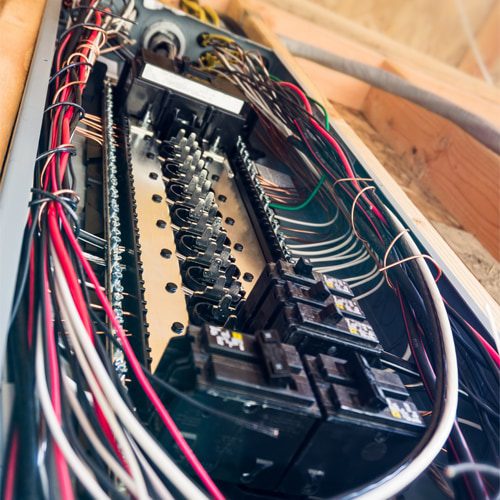
Reading the Circuit Breaker Box
Locating the Panel Box
Most circuit breaker panels are located in basements, garages, or utility rooms. They are typically gray metal boxes that are mounted on the wall. If you’re unsure where your service panel is located, check the home inspection report you received when purchasing your home, as it should be listed there.
Identifying Different Breakers
Once you open the panel, you’ll see an array of switches, each protecting a different part of your home. Here are some common types of circuit breakers you may encounter:
Single-Pole Breakers:
These are the most common type and have a single switch. They are typically used for lights and receptacles. Single-pole breakers provide one electrical circuit, typically at 120 volts, and usually come with amperage ratings of 15- or 20-amps.
The 15-amp breakers are appropriate for low-power draw applications, while 20-amp breakers are often found in the kitchen where appliances need more electrical current.
Double-Pole Breakers:
Physically larger than single-pole breakers, these breakers have two connected switches and take up two slots in the panel. They are often used for appliances that require more power, like electric stoves, dryers, or air conditioning units. These breakers can deliver 240 volts and their amperage ratings are usually higher, ranging from 30 to 60 amps or more.
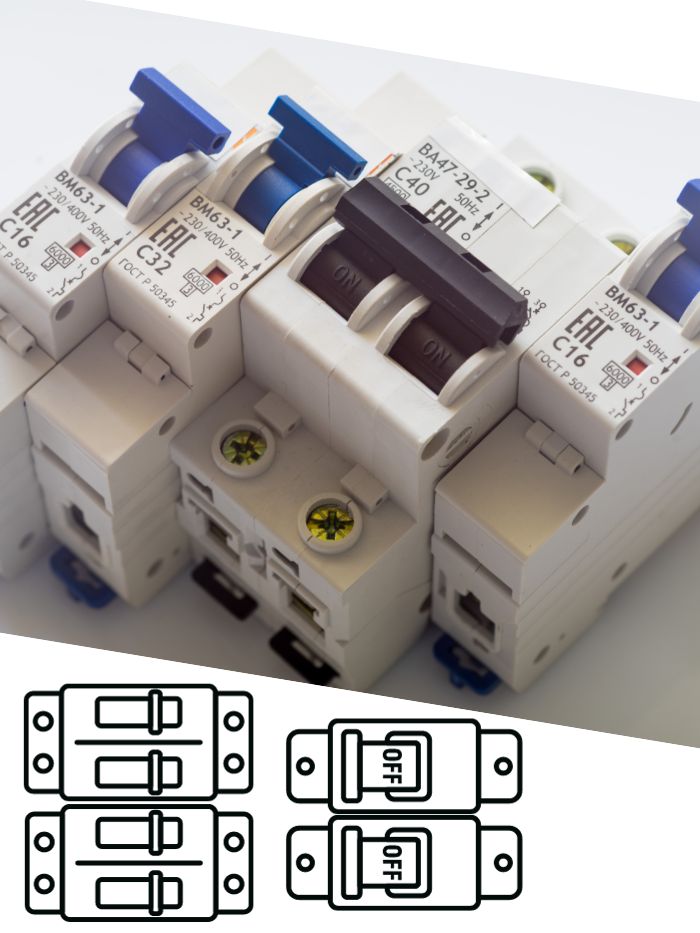
GFCI (Ground-Fault Circuit Interrupter) Breakers:
These are specialized breakers with additional safety features to protect against ground faults. They are often required by code in areas where water is present, like bathrooms and kitchens, to prevent electrocution.
One of the most obvious ways to identify a GFCI breaker is by the presence of “Test” and “Reset” buttons on the breaker itself. These buttons allow you to manually trip and reset the breaker to ensure it’s working correctly. In addition to these buttons, GFCI breakers are usually clearly labeled with “GFCI” or “Ground-Fault Circuit Interrupter” on or near the switch.
Some modern GFCI breakers have an LED indicator that changes color based on the breaker’s status. For example, green could indicate that the GFCI protection is active, while red may indicate a tripped or malfunctioning breaker.
AFCI (Arc-Fault Circuit Interrupter) Breakers:
These breakers are designed to prevent electrical fires by detecting unintended electrical arcs, which could indicate that electricity is sparking between wires and may pose a fire risk. In newer homes this style of protection is required for living spaces including the kitchen, living room, and bedrooms.
Like GFCI breakers, AFCI breakers are usually labeled as such. You’ll see “AFCI” or “Arc-Fault Circuit Interrupter” printed on or near the switch. While AFCI breakers usually have a test button, they typically do not have a reset button.
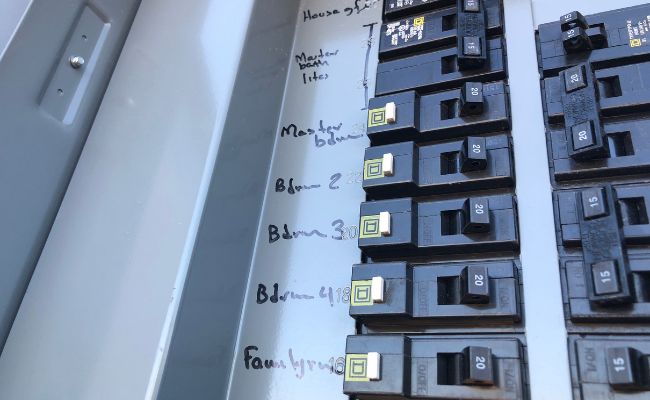
Combination Breakers:
Some breakers offer both GFCI and AFCI protection. These are known as “Dual Function” or “Combination” breakers, and they will typically have both “Test” and “Reset” buttons, along with labels indicating that they provide both GFCI and AFCI protection.
Understanding the Labels
You’ll often see handwritten or printed labels next to each switch. These labels are intended to help you identify what each breaker controls—whether it’s an individual room like the kitchen, or specific appliances like the dishwasher.
In a perfect world, these labels will be clear, concise, and legible… however we can safely say that some are anything but! If your labels are unclear, we recommend going through and updating them. This will make future electrical work and problem diagnosis easier.
Interpreting the Switch Positions
Circuit breakers have three main positions:
- On Position (Switch facing towards center of box): This means the electrical flow is uninterrupted.
- Off Position (Switch facing towards outside of box): This position indicates that the circuit is disconnected.
- Tripped (Middle position): When a breaker has automatically switched to a middle position, it has ‘tripped’ due to an overload or other issue. Often a tripped circuit breaker only looks subtly different from its ‘On’ state, so compare it to the circuit above and below to be sure.
Resetting a Tripped Breaker
To reset a tripped breaker:
- Locate the breaker that is in the middle or “Off” position.
- Turn the breaker fully to the “Off” position.
- Turn it back to the “On” position.
The circuit should now be restored.
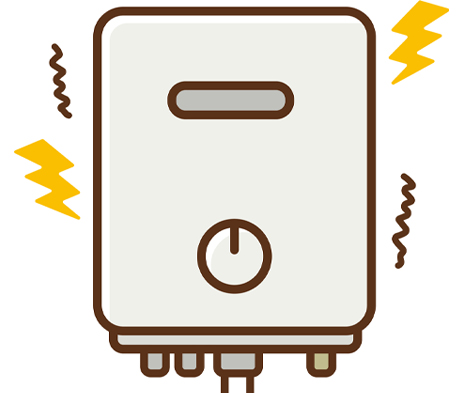
Common Issues and Troubleshooting
Circuit Breaker Trips Frequently
If a breaker frequently trips, it might be due to overloading the circuit or an issue with an appliance. First, try unplugging a few devices and see if that solves the issue. Remember, multiple outlets can be on the same circuit, so you may need to use plugs from a different room to spread the load out to a different circuit.
If this doesn’t solve your problem then you will need to consult an electrician.
Breakers that Won’t Reset
If a breaker won’t reset, this is often an indication of a more serious problem. Do not force it back into place. Instead, seek professional help immediately.
Older Circuit Breaker Panels
Older electrical panels may have obsolete components and can become a fire hazard. If you have an older home with an original panel, it’s wise to have it assessed by a professional. A common model of breaker panel to look out for are Federal Pacific Circuit Breakers. Made between 1950 and late 1980s, these breakers are a known fire risk and should be replaced as soon as possible! The risk unfortunately doesn’t stop with older panels – in 2022 Schneider Electric recalled over a million panels manufactured between 2020 and 2022 due to potential fire risk.
It’s always a good idea to have a qualified electrician perform an inspection to ensure your home’s electrical system is safe and operating as it should.
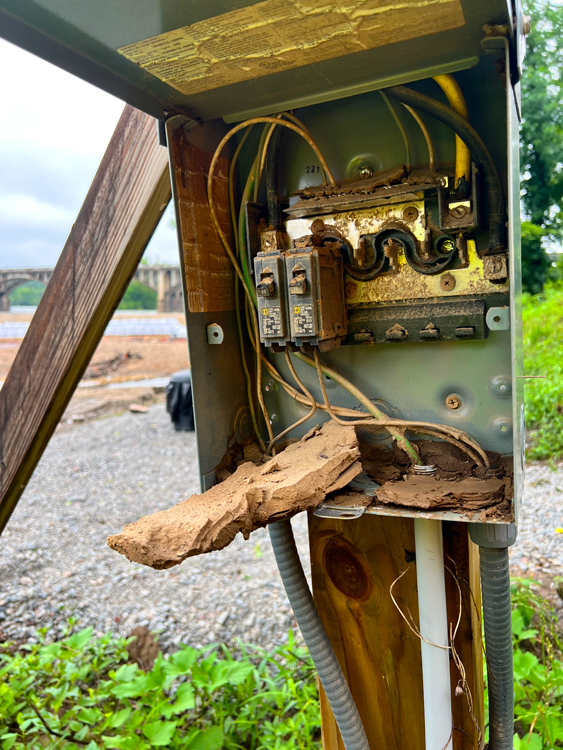
Safety Tips When Dealing with Circuit Breakers
- When resetting a breaker, it is a good idea to deload the circuit first. High draw appliances like heaters should be turned off or unplugged.
- Never touch the panel with wet hands or stand in water while operating it.
- Don’t attempt to remove the panel cover. There are no DIY tasks behind this cover – leave it to the professionals.
- If you’re unsure, consult a qualified electrician. It’s always better to be safe.
Understanding Circuit Breakers
Understanding your home’s circuit breaker panel is crucial for basic home maintenance and electrical safety. Although dealing with electricity can be intimidating, knowing how to read and reset your circuit breaker can empower you to handle minor issues with confidence.
If you experience more issues like breakers repeatedly tripping or can’t reset a breaker after it has tripped, you should contact a local licensed electrician.
